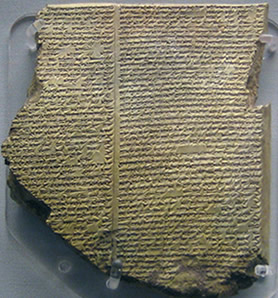
Edition
The translation and Arabic transliteration provided in this study include evidence from a Standard Edition tablet piece found couple decades ago in Ugarit, currently Ras Shamrah of northern Syria. The 38 lines recovered from this twelfth-century (BCE) Ugaritic tablet correspond to Tablet I of the Standard Edition, but are in some disorder. Nevertheless, they help considerably in restoring the opening lines of the Epic and reconstructing the lines describing the Gilgamesh's body size. George's transliteration and translation of this tablet piece are provided in his article The Gilgameš epic at Ugarit (Aula Orientalis 25 (2007) 237-254).
This translation and transliteration are also based, partially, on the Latin transliteration of the recovered tablets of the Old Babylonian Edition (OBE) (early second millennium BCE), which was prepared by Morris Jastrow and is provided by Project Gutenberg. Unfortunately, only two tablets were recovered from this older edition, which evidently contains a much clearer early Classical Arabic language.
It should be pointed out here that it would be impossible to produce, with complete certainty, a final and definitive translation or transliteration of the Epic of Gilgamesh due to medium damage, tracing uncertainty, and old language and script complexity, let alone possible scribe errors. It is not apparent, either, that the full standard edition was actually written in the form of poetic verses or "scores,." as indicated by many translators. Therefore, this new translation will treat the epic as a story, not poem, providing alternative translations and transliterations, when needed, to accommodate questionable, missing, or multiple-meaning words. This translation will also attempt to preserve any original Arabic grammar structure and vocabulary, when possible.
Acknowledgement
Needless to say, this work would not have been possible without the work or help from others, like Andrew George, whose book, The Babylonian Gilgamesh Epic: Introduction, Critical Edition and Cuneiform Texts (Oxford: Oxford University Press, 2003), is indispensable; time and again, the researcher of this new translation found himself at lost before consulting the in-depth translation provided by it. The early Arab and Muslim scholars who left us many magnificent etymological Arabic references. Ra’id Na`im, who provided a public full-text database search engine of the most important ones of these scholarly references in his al-Bahith al-Arabi. The numerous Western scholars who compiled, over several decades The Assyrian Dictionary of the Oriental Institute of the University of Chicago (CAD). The Scholars who produced the excellent Electronic Pennsylvania Sumerian Dictionary (ePSD), an exhaustive database of the Sumerian and Akkadian languages provided by the University of Pennsylvania. Ali Yassin al-Jiboury, who pointed out eloquently the Arabic roots of the Akkadian words in the introduction of his Arabic-Akkadian Language Dictionary (The National Library at the Abu Dhabi Authority for Culture and Heritage, 2009), tracing more than 1700 such Arabic words. Muzahim Jalili, an expert student of the Cuneiform writing and the Sumerian and Akkadian languages, who helped me understand some inner details of the “Assyriological method.”
Downloading the Arabic Transliteration and the New Arabic and English Translations of the Epic of Gilgamesh
This new translation and Arabic transliteration will be provided as an ongoing (tablet-by-tablet) open study, in order to further improve it by feedback from interested scholars, particularly Arabic language scholars, and by incorporating any new evidence, when available. Translator's notes along with the evidence of older Arabic and modern Western etymological references, are provided in this ongoing updated Gilgamesh Epic Words Index. Updated files will be dated, when available. Latin transliterations of the original Cuneiform text are also provided for reference.
• Tablet 1 English / Arabic Translation & Arabic Transliteration (PDF) [10/21/2016]
Latin Transliteration SBE (PDF) | Latin Transliteration OBE (PDF) | Latin Transliteration Ugaritic SBE (PDF)
• Tablet 10 English / Arabic Translation & Arabic Transliteration (PDF) [10/21/2016]
Latin Transliteration SBE (PDF)
• Tablet 11 English / Arabic Translation & Arabic Transliteration (PDF) [10/21/2016]
Latin Transliteration SBE (PDF)
Downloading the Arabic Transliteration and the Arabic and English Translations of the Law Code of Hammurabi
For more Arabic-based translation samples, you can download below part 1 of our book "The Law Code of Hammurabi" which includes the transliterations and translations of the laws of King Hammurabi (1810-1750 BCE), as an additional sample of a non-literary work of a much older Babylonian language, based on the Latin transliteration provided by Robert Francis Harper (1864-1914). Also provided here is the referenced words index from the modern Assyriology dictionaries and the historical Arabic manuscripts.
• Hammurabi Laws English / Arabic Translations & Arabic Transliteration (PDF) [12/15/2017]